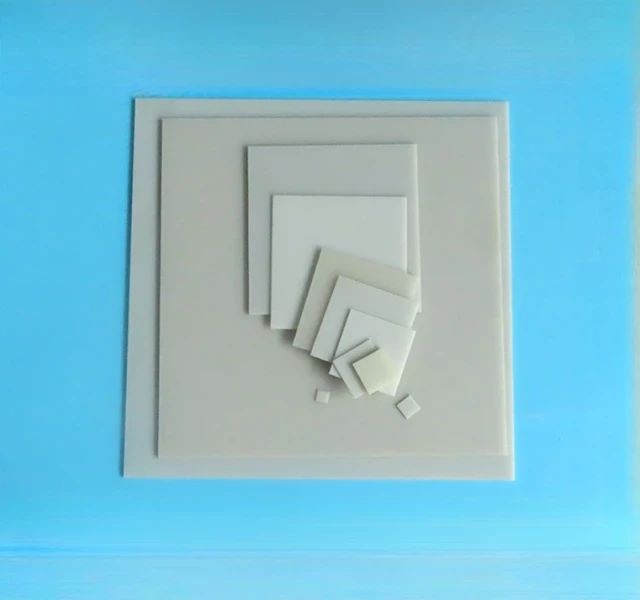
fine ceramics
Advanced Engineering Fine Ceramics Aluminum Nitride (AlN) Ceramic Sheet
Item Number : KM-DG05
Price varies based on specs and customizations
- Material
- Silicon nitride
- Specification
- See the form
- Size / Shape
- Customizable
Shipping:
Contact us to get shipping details Enjoy On-time Dispatch Guarantee.
Why Choose Us
Reliable PartnerEasy ordering process, quality products, and dedicated support for your business success.
Application
Aluminum nitride (AlN) is a ceramic material with high thermal conductivity and electrical insulation capabilities. It is commonly used in electrical equipment and is resistant to erosion by molten metal. It is also a suitable replacement for beryllium oxide (BeO) in the semiconductor industry because it is non-toxic and has similar properties to the silicon wafer material.
The thermal expansion coefficient is similar to that of silicon, good light transmission performance, and non-toxic. Compared with alumina and beryllium oxide ceramics, it has high mechanical strength. Aluminum nitride (AlN) ceramics are known for their high thermal conductivity and excellent electrical insulation properties. They are suitable for a wide variety of electrical equipment and offer several advantages in industrial applications.
- Thermal management and electrical applications requiring high thermal conductivity and electrical insulation.
- Semiconductor devices such as ceramic trays and etch masks.
- Chip cooling and support.
- Aluminum nitride ceramic substrates for OLEDs.
- Steel and semiconductor manufacturing.
- Wafer handling and processing.
- Crucibles for crystal growth.
- Microelectronic devices, including substrates, insulators and chip carriers.
- Laser thermal management components.
- Dielectric layers in optical storage media.
- Packaging for microwave equipment.
- Power electronics, including electrical insulators, heat sinks, rectifiers and power modules.
- Aerospace applications.
- LED packages and power resistors.
Detail & Parts

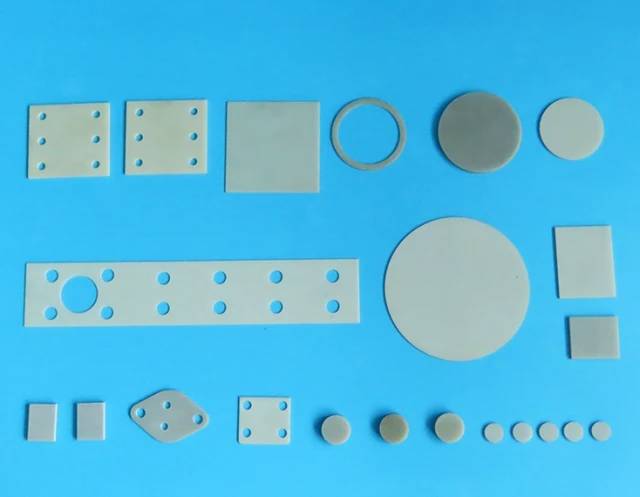


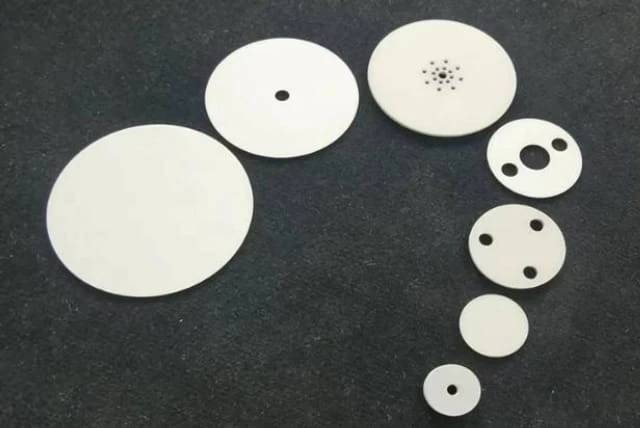




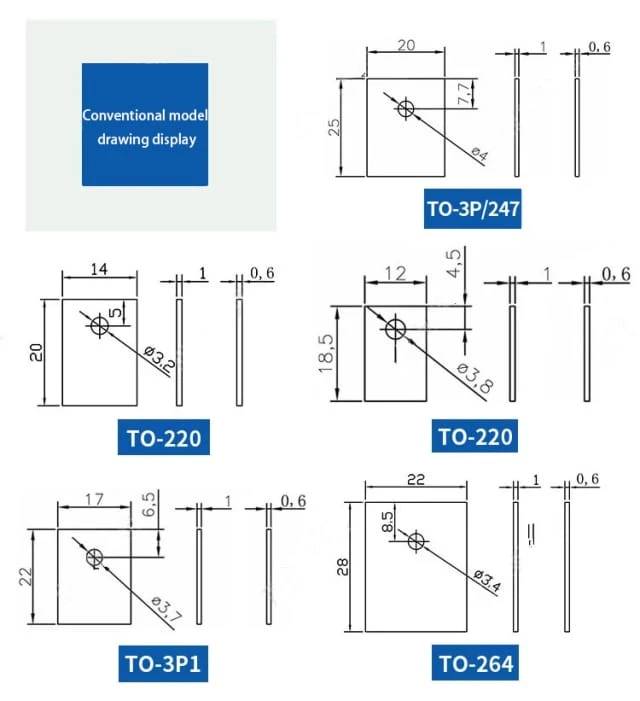
Technical specifications
| Product number | Product regular size (mm) | |
| Porous aluminum nitride ceramic sheet | 14*19*1 | 14*19*1 |
| 20*25*1 | 20*25*1 | |
| 22*28*1 | 22*28*1 | |
| 29*42*1 | 17*22*0.6 | |
| Round140.385 | ||
| Non-porous aluminum nitride ceramic sheet | 6*30*1 | 114*114*1 |
| 20*25*1 | 127*127*1 | |
| 3.6*3.6*0.385 | 139*190.5*1 | |
| 10*10*1 | 152.4*152.4*0.6 | |
| 30*30*1 | 152.4*152.4*1 | |
| 40*40*1 | 165*165*1 | |
| 50*50*1 | 25*98*0.635 | |
| 1016*101.60.38 | 50*50*0.5 | |
| 101.6*101.6*0.635 | Round31*1.2 | |
| 114*114*0.385 | Round26*1 | |
| 1143*114.30.635 | Round72.6*0.6 | |
| Round15*1.5 | Round45*1 | |
| Round26*1 | Round45*1.5 | |
| Round30*1 | Round50*1 | |
| Round35*1 | Round50*2 | |
| Round40*1 | Round60*1 |
The produce we show are available in different sizes and custom sizes are available on request.
Advantages
- High thermal conductivity enables efficient heat dissipation and improves device performance.
- Compatibility with silicon contributes to the reliability of silicon chips and thermal cycling.
- Excellent electrical insulation and low dielectric constant.
- High mechanical strength, providing durability in industrial processes.
- Corrosion resistant to molten metals.
- Non-toxic, high purity.
FAQ
What Are The Main Applications Of Fine Ceramics?
What Are Engineering Ceramics?
What Are Advanced Ceramics?
What Are The Main Types Of Fine Ceramics?
What Are The Main Types Of Engineering Ceramics?
What Are The Main Types Of Advanced Ceramics?
What Is The Principle Behind Fine Ceramics?
What Are The Applications Of Engineering Ceramics?
What Are The Applications Of Advanced Ceramics?
What Are The Advantages Of Using Fine Ceramics?
How Do Engineering Ceramics Differ From Traditional Ceramics?
How Are Advanced Ceramics Manufactured?
What Are The Advantages Of Using Alumina Ceramics?
What Are The Advantages Of Using Advanced Ceramics?
Why Are Zirconia Ceramics Preferred In Certain Applications?
What Is The Difference Between Alumina And Zirconia Ceramics?
What Makes Silicon Carbide Ceramics Suitable For High-temperature Applications?
Why Are Silicon Carbide Ceramics Used In High-temperature Applications?
How Are Boron Nitride Ceramics Used In Electronics?
What Makes Boron Nitride Ceramics Unique?
What Is The Manufacturing Process Of Engineering Ceramics?
How Do Advanced Ceramics Contribute To Energy Efficiency?
Can Engineering Ceramics Be Customized For Specific Applications?
4.8
out of
5
An incredibly cost-effective solution for my lab's thermal management needs. Highly recommended!
4.9
out of
5
Excellent product! It arrived on time and met all my requirements. Great quality!
4.7
out of
5
Impressed by its exceptional thermal conductivity and durability. It's a game-changer for my lab's research.
4.6
out of
5
I appreciate the fast shipping and the top-notch quality of this ceramic sheet.
4.9
out of
5
The product's high thermal conductivity and electrical insulation properties are top-notch. A great choice for my lab's electrical equipment.
4.8
out of
5
The non-toxicity and high purity of this ceramic sheet make it a safe and reliable choice for my lab's applications.
4.7
out of
5
The custom sizes available ensure a perfect fit for my lab's specific needs. Kudos to the manufacturer!
4.6
out of
5
I'm thoroughly impressed with the corrosion resistance of this ceramic sheet. It's a perfect fit for my lab's harsh conditions.
REQUEST A QUOTE
Our professional team will reply to you within one business day. Please feel free to contact us!
Related Products

High Temperature Wear-Resistant Alumina Al2O3 Plate for Engineering Advanced Fine Ceramics
High temperature wear-resistant insulating alumina plate has excellent insulation performance and high temperature resistance.
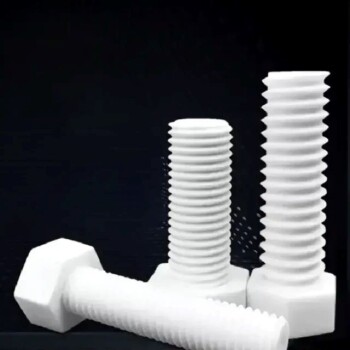
Alumina ceramic screws are fastening components made of 99.5% alumina, ideal for extreme applications requiring excellent thermal resistance, electrical insulation and chemical resistance.

High Temperature Alumina (Al2O3) Furnace Tube for Engineering Advanced Fine Ceramics
High temperature alumina furnace tube combines the advantages of high hardness of alumina, good chemical inertness and steel, and has excellent wear resistance, thermal shock resistance and mechanical shock resistance.
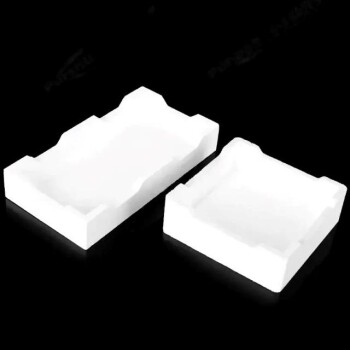
Advanced Engineering Fine Ceramics Alumina Ceramic Saggar for Fine Corundum
Alumina sagger products have the characteristics of high temperature resistance, good thermal shock stability, small expansion coefficient, anti-stripping, and good anti-powdering performance.

In the journey of scientific exploration and industrial production, every detail is crucial. Our arc-shaped alumina ceramic crucibles, with their excellent high temperature resistance and stable chemical properties, have become a powerful assistant in laboratories and industrial fields. They are made of high-purity alumina materials and manufactured through precision processes to ensure excellent performance in extreme environments.

Alumina ceramics have good electrical conductivity, mechanical strength and high temperature resistance, while zirconia ceramics are known for their high strength and high toughness and are widely used.

Precision Machined Zirconia Ceramic Ball for Engineering Advanced Fine Ceramics
zirconia ceramic ball have the characteristics of high strength, high hardness, PPM wear level, high fracture toughness, good wear resistance, and high specific gravity.

Zirconia Ceramic Gasket Insulating Engineering Advanced Fine Ceramics
Zirconia insulating ceramic gasket has high melting point, high resistivity, low thermal expansion coefficient and other properties, making it an important high temperature resistant material, ceramic insulating material and ceramic sunscreen material.

Silicon Carbide (SIC) Ceramic Sheet Wear-Resistant Engineering Advanced Fine Ceramics
Silicon carbide (sic) ceramic sheet is composed of high-purity silicon carbide and ultra-fine powder, which is formed by vibration molding and high-temperature sintering.
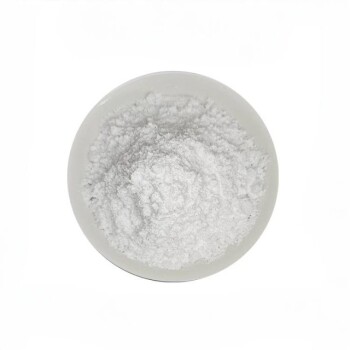
Advanced Engineering Fine Ceramics Low Temperature Alumina Granulation Powder
Low temperature alumina granulation powder is a kind of alumina particles produced by a special low temperature process, designed to meet the needs of temperature sensitive applications. This material has excellent low temperature performance and good processing characteristics, suitable for a variety of industries that require low temperature processing and treatment.
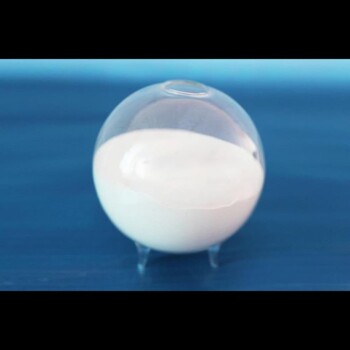
High Purity Alumina Granulated Powder for Engineering Advanced Fine Ceramics
Ordinary alumina granulated powder is alumina particles prepared by traditional processes, with a wide range of applications and good market adaptability. This material is known for its high purity, excellent thermal stability and chemical stability, and is suitable for a variety of high-temperature and conventional applications.
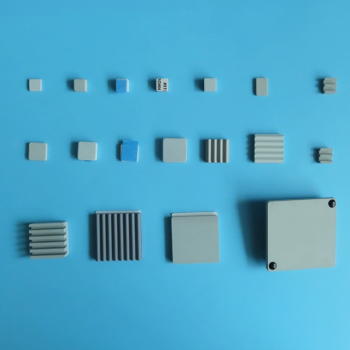
Silicon Carbide (SIC) Ceramic Sheet Flat Corrugated Heat Sink for Engineering Advanced Fine Ceramics
Silicon carbide (sic) ceramic heat sink not only does not generate electromagnetic waves, but also can isolate electromagnetic waves and absorb part of electromagnetic waves.

Precision Machined Yttria Stabilized Zirconia Ceramic Plate for Engineering Advanced Fine Ceramics
Yttrium-stabilized zirconia has the characteristics of high hardness and high temperature resistance, and has become an important material in the field of refractories and special ceramics.

Precision Machined Silicon Nitride (SiN) Ceramic Sheet for Engineering Advanced Fine Ceramics
Silicon nitride plate is a commonly used ceramic material in the metallurgical industry due to its uniform performance at high temperatures.
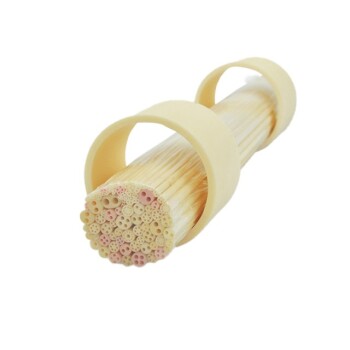
High Temperature Aluminum Oxide (Al2O3) Protective Tube for Engineering Advanced Fine Ceramics
Alumina oxide protective tube, also known as high temperature resistant corundum tube or thermocouple protection tube, is a ceramic tube mainly made of alumina (aluminum oxide).

Alumina wear-resistant ceramic washer are used for heat dissipation, which can replace aluminum heat sinks, with high temperature resistance and high thermal conductivity.
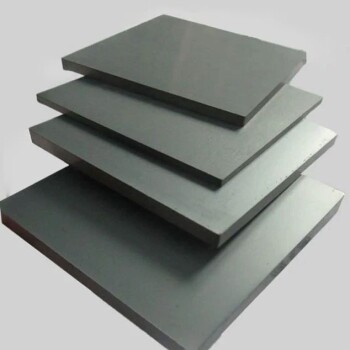
Silicon Carbide (SIC) Ceramic Plate for Engineering Advanced Fine Ceramics
Silicon nitride (sic) ceramic is an inorganic material ceramic that does not shrink during sintering. It is a high-strength, low-density, high-temperature-resistant covalent bond compound.

Precision Machined Yttrium Stabilized Zirconia Ceramic Rod for Engineering Advanced Fine Ceramics
Zirconia ceramic rods are prepared by isostatic pressing, and a uniform, dense and smooth ceramic layer and transition layer are formed at high temperature and high speed.

Engineering Advanced Fine Ceramics Head Tweezers with Pointed Elbow Zirconia Ceramic Tip
Zirconia ceramic tweezers are a high-precision tool made of advanced ceramic materials, especially suitable for operating environments that require high precision and corrosion resistance. This type of tweezers not only has excellent physical properties, but is also popular in the medical and laboratory fields because of its biocompatibility.
Related Articles

The Future of Lab Presses in Research and Development
Lab presses are an essential tool in research and development for a wide range of industries, including pharmaceuticals, materials science, and electronics.

Advanced Alumina Ceramics: Applications and Manufacturing Techniques
This article discusses the applications and manufacturing techniques of advanced alumina ceramics, including molds, isostatic pressing, and green bodies.

Advanced Alumina Ceramics: Applications and Manufacturing Techniques
Overview of alumina ceramics' applications and manufacturing methods, including molds, isostatic pressing, and green body formation.

The 5 Hottest Advanced Ceramic Powders Currently Available!
An overview of the top 5 advanced ceramic powders: High Purity Aluminum Oxide, Boehmite, Aluminum Nitride, Silicon Nitride, and Spherical Alumina, highlighting their applications and market trends.

Precision Ceramic Materials for Energy Conversion Applications
Overview of various ceramic materials used in energy conversion technologies, including heaters, piezoelectric ceramics, and solid oxide fuel cells.

AI Chip Advancement Driven by Metallic New Materials
Explores how AI chip upgrades are fueled by new metal materials, impacting computing power and semiconductor manufacturing.

Precision Ceramics in Semiconductor Applications
Exploring the use of precision ceramics in semiconductor equipment, their properties, and manufacturing processes.

Engineering Ceramic Materials: Applications in Aerospace, Electronic Information, New Energy, and Environmental Protection
This article explores the diverse applications of engineering ceramic materials across aerospace, electronic information, new energy, and environmental protection sectors.

MPCVD Single Crystal Diamond Applications in Semiconductor and Optical Display Fields
This article discusses the applications of MPCVD single crystal diamond in semiconductor and optical display fields, highlighting its superior properties and potential impact on various industries.

Mechanical Properties and Structural Enhancements of Ceramics
An in-depth analysis of the mechanical properties of ceramics, including strengths, weaknesses, and methods for improvement.

Understanding Zirconia Ceramic Cold Isostatic Pressing
In the world of manufacturing, one technique that has gained significant popularity is Zirconia Ceramic Cold Isostatic Pressing (CIP). it's a process that involves applying high-pressure fluid or gas to shape and form ceramic materials.